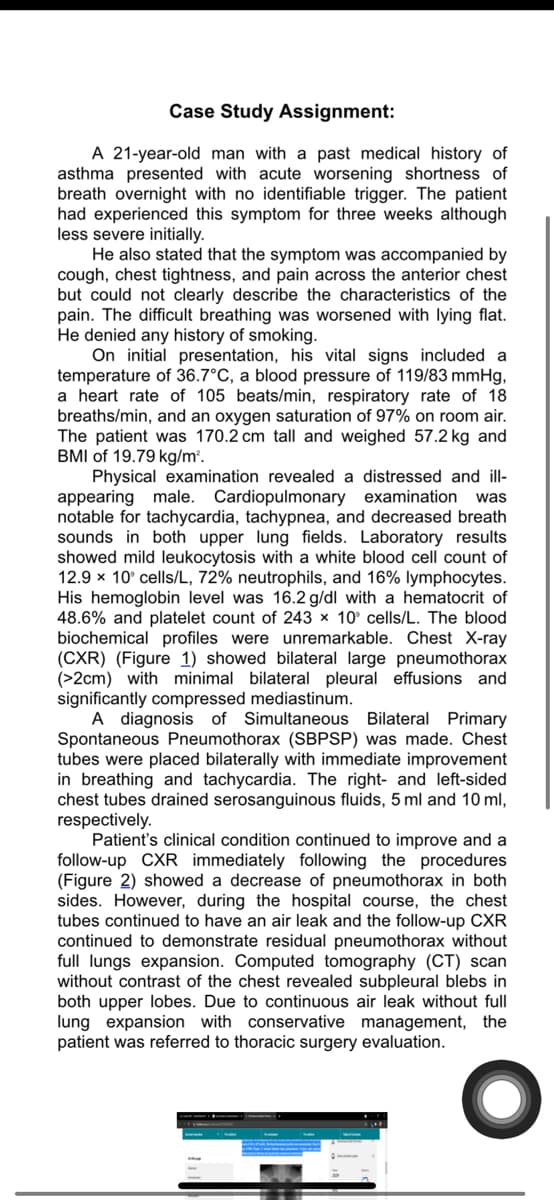Surgical Tech For Surgical Tech Pos Care
5th Edition
ISBN:9781337648868
Author:Association
Publisher:Association
Chapter9: Surgical Pharmacology And Anesthesia
Section: Chapter Questions
Problem 3CS
Related questions
Question
Top 2 nursing priority diagnosis

Transcribed Image Text:Case Study Assignment:
A 21-year-old man with a past medical history of
asthma presented with acute worsening shortness of
breath overnight with no identifiable trigger. The patient
had experienced this symptom for three weeks although
less severe initially.
He also stated that the symptom was accompanied by
cough, chest tightness, and pain across the anterior chest
but could not clearly describe the characteristics of the
pain. The difficult breathing was worsened with lying flat.
He denied any history of smoking.
On initial presentation, his vital signs included a
temperature of 36.7°C, a blood pressure of 119/83 mmHg,
a heart rate of 105 beats/min, respiratory rate of 18
breaths/min, and an oxygen saturation of 97% on room air.
The patient was 170.2 cm tall and weighed 57.2 kg and
BMI of 19.79 kg/m³.
Physical examination revealed a distressed and ill-
appearing male. Cardiopulmonary examination was
notable for tachycardia, tachypnea, and decreased breath
sounds in both upper lung fields. Laboratory results
showed mild leukocytosis with a white blood cell count of
12.9 x 10° cells/L, 72% neutrophils, and 16% lymphocytes.
His hemoglobin level was 16.2 g/dl with a hematocrit of
48.6% and platelet count of 243 x 10° cells/L. The blood
biochemical profiles were unremarkable. Chest X-ray
(CXR) (Figure 1) showed bilateral large pneumothorax
(>2cm) with minimal bilateral pleural effusions and
significantly compressed mediastinum.
A diagnosis of Simultaneous Bilateral Primary
Spontaneous Pneumothorax (SBPSP) was made. Chest
tubes were placed bilaterally with immediate improvement
in breathing and tachycardia. The right- and left-sided
chest tubes drained serosanguinous fluids, 5 ml and 10 ml,
respectively.
Patient's clinical condition continued to improve and a
follow-up CXR immediately following the procedures
(Figure 2) showed a decrease of pneumothorax in both
sides. However, during the hospital course, the chest
tubes continued to have an air leak and the follow-up CXR
continued to demonstrate residual pneumothorax without
full lungs expansion. Computed tomography (CT) scan
without contrast of the chest revealed subpleural blebs in
both upper lobes. Due to continuous air leak without full
lung expansion with conservative management, the
patient was referred to thoracic surgery evaluation.
Expert Solution
This question has been solved!
Explore an expertly crafted, step-by-step solution for a thorough understanding of key concepts.
Step by step
Solved in 3 steps

Knowledge Booster
Learn more about
Need a deep-dive on the concept behind this application? Look no further. Learn more about this topic, nursing and related others by exploring similar questions and additional content below.Recommended textbooks for you

Surgical Tech For Surgical Tech Pos Care
Health & Nutrition
ISBN:
9781337648868
Author:
Association
Publisher:
Cengage

Basic Clinical Lab Competencies for Respiratory C…
Nursing
ISBN:
9781285244662
Author:
White
Publisher:
Cengage

Surgical Tech For Surgical Tech Pos Care
Health & Nutrition
ISBN:
9781337648868
Author:
Association
Publisher:
Cengage

Basic Clinical Lab Competencies for Respiratory C…
Nursing
ISBN:
9781285244662
Author:
White
Publisher:
Cengage